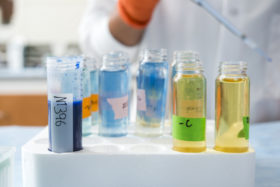– Wendy Adams, Research Grant Director, Bay Area Lyme Foundation
Bay Area Lyme has a goal to leverage the entrepreneurial spirit and innovation of Silicon Valley in order to catalyze novel projects around the country. Our belief is that the application of cutting-edge technologies will have a dramatic impact on making Lyme disease easy to diagnose and simple to cure. We collaborate with world-class scientists focused on Lyme projects which leverage knowledge from other fields of medicine and research. We also prioritize engagement with the investment and biotech communities so that breakthroughs in the laboratory can be translated more quickly to patients. Since our inception, our scientific research funding priorities have been focused on supporting diagnostic and therapeutic projects.
It is impossible to cure Lyme disease in every case without understanding how to diagnose it accurately. There are many reasons for this disease being difficult to identify—ticks are tiny, the EM skin rash is often misdiagnosed and symptoms overlap with other acute diseases like influenza. Most importantly, the widely used two tier diagnostic testing required for Lyme disease is currently the ELISA and Western Blot, which only detects the immune response (indirect detection) and not the pathogen itself. Because it can take at least 2-4 weeks for the body to generate antibodies, these tests have been shown to miss up to 70% of acute Lyme cases. These tests also do not detect other related Borrelia species, such as Borrelia miyamotoi), and cannot determine when the infection is eradicated.
Now more than ever, there is both the need and opportunity for better direct detection diagnostics. New advances in genomics, proteomics, metabolomics, nanotechnology, microarrays, high-throughput sequencing, and imaging offer promising new approaches for both direct and indirect detection. Innovative scientists are applying technologies and novel approaches from other fields of medicine with encouraging results. Accurate diagnostics enable other activities—better clinical trials and clinical care, and more accurate therapeutic development being chief among them. If you can’t assess cure rates, how can you tell if a treatment (antibiotics or another therapeutic) is or is not efficacious?
At Bay Area Lyme, we are particularly focused on direct detection solutions because showing evidence of the pathogen itself, not just the immune response, is the gold standard for infectious disease testing. To that end, BAL funded Ceres Nanosciences, Inc in 2017, as an opportunity to bring new technology to Lyme diagnostics. At the time, Ceres was looking to bring their proven track record (and substantial funding) in cancer and other infectious diseases to Lyme disease. BAL saw incredible promise in their Nanotrap® particle technology which uses a bait trap to concentrate the analyte (in this case the OspA protein, which is specific to B. burgdorferi) in a capsule and then reads the capsule contents instead of trying to find the analyte in the whole sample.
In addition to this funding, an important collaboration with BAL’s Lyme Disease Biobank (LDB) contributed to the success of Ceres’ Nanotrap® technology. In addition to collecting its own samples, LDB has helped companies set up direct collection through our clinical sites, for sample types or volumes not offered by the LDB collection. This collaboration was important in helping Ceres collect urine samples to investigate their technology. Establishing Lyme clinical trial expertise in the medical community can be helpful to all stakeholders in Lyme disease, and BAL is proud to have supported this effort.
As recently reported, Galaxy Diagnostics has now licensed the Nanotrap® Urine Test and has launched a highly sensitive test for direct detection of Lyme disease. This strategy allows Ceres to focus on more indications and concentrate on technology development and improvement as opposed to becoming a research lab itself.
Initial research has shown that the Ceres/Galaxy Nanotrap Urine Test is effective in confirming early stage Lyme borreliosis in patients with EM rashes. According to Galaxy, their unpublished validation data has shown that the Nanotrap® Urine Test will often confirm active infection in patients who test negative with the two-tier serological test. BAL is grateful to Ceres for bringing their technology to Lyme diagnostics, and proud to have contributed to Ceres’ success in the marketplace.

I would like to help in any way with offering samples to test. My entire family has Lyme and many coinfections. There are 6 of us.
Thanks for all the research you are doing. This country needs to get on this disease!
Thank you, Jennifer. Please consider donating samples to the Lyme Disease Biobank for research.
https://www.bayarealyme.org/our-research/biobank/
Excellent! I trust this technique will be accepted by western medicine to prove the existence of the infection. I’ve dealt with this battle for 23 years and have suffered the consequences of not having “A Test”. It’s been my experience our medical corp is not very well informed anyway and just will continue to see a psychiatrist.
Thank you for all your research!